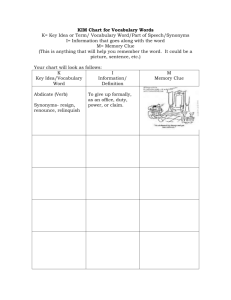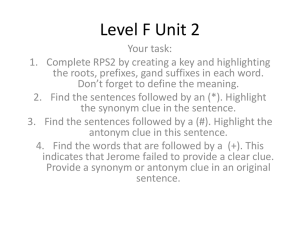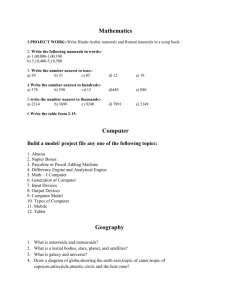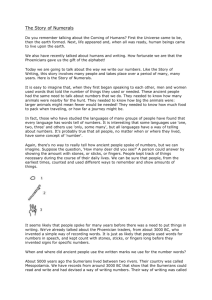North Middlesex_Module_Math Ancient World
advertisement
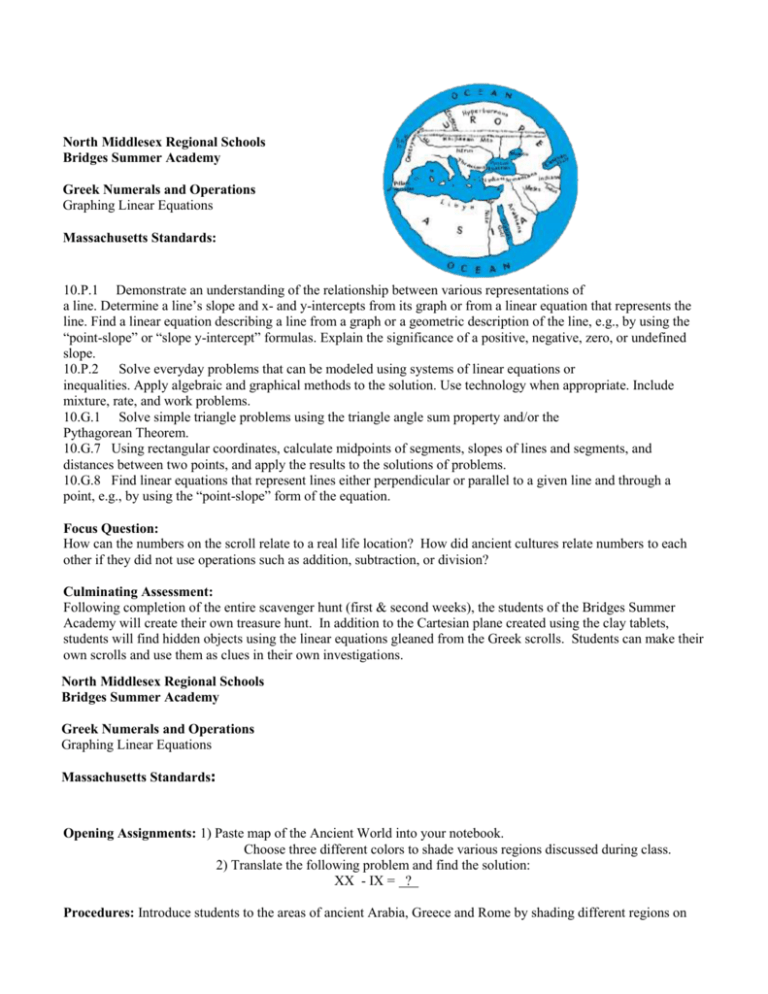
North Middlesex Regional Schools Bridges Summer Academy Greek Numerals and Operations Graphing Linear Equations Massachusetts Standards: 10.P.1 Demonstrate an understanding of the relationship between various representations of a line. Determine a line’s slope and x- and y-intercepts from its graph or from a linear equation that represents the line. Find a linear equation describing a line from a graph or a geometric description of the line, e.g., by using the “point-slope” or “slope y-intercept” formulas. Explain the significance of a positive, negative, zero, or undefined slope. 10.P.2 Solve everyday problems that can be modeled using systems of linear equations or inequalities. Apply algebraic and graphical methods to the solution. Use technology when appropriate. Include mixture, rate, and work problems. 10.G.1 Solve simple triangle problems using the triangle angle sum property and/or the Pythagorean Theorem. 10.G.7 Using rectangular coordinates, calculate midpoints of segments, slopes of lines and segments, and distances between two points, and apply the results to the solutions of problems. 10.G.8 Find linear equations that represent lines either perpendicular or parallel to a given line and through a point, e.g., by using the “point-slope” form of the equation. Focus Question: How can the numbers on the scroll relate to a real life location? How did ancient cultures relate numbers to each other if they did not use operations such as addition, subtraction, or division? Culminating Assessment: Following completion of the entire scavenger hunt (first & second weeks), the students of the Bridges Summer Academy will create their own treasure hunt. In addition to the Cartesian plane created using the clay tablets, students will find hidden objects using the linear equations gleaned from the Greek scrolls. Students can make their own scrolls and use them as clues in their own investigations. North Middlesex Regional Schools Bridges Summer Academy Greek Numerals and Operations Graphing Linear Equations Strategies: Massachusetts Standards: Opening Assignments: 1) Paste map of the Ancient World into your notebook. Choose three different colors to shade various regions discussed during class. 2) Translate the following problem and find the solution: XX - IX = ? Procedures: Introduce students to the areas of ancient Arabia, Greece and Rome by shading different regions on the map. These different cultures each represent the development of important ideas in science and math. Ancient Babylonia was dominated by trade and commerce which caused many ideas to cross borders, and began what some view as the early stages of civilization. The numeral symbols that we use today are taken from the Hindu-Arabic cultures. The Greeks then conquered much of Persia in the time of Alexander the Great. Rome, in turn, grew to power filling the power vacuum left by Alexander’s death. While this description is simplistic, the focus of this activity will be on the mathematical concepts found on the scrolls. Throughout history, people have approached math in various ways. Each used different symbols to represent numbers and calculated sums, products and differences using distinct methods. Few cultures actually used symbols to denote operations. This absence of operational symbols is the focus of this lesson. Students should be made aware that these ancient mathematicians did not use symbols to represent operations such as addition or multiplication. The problems were solved by recognizing patterns within previous problems. For example, if students are given 2, 2, and 4, they then need to ask themselves what was done with 2 and 2 to get 4. The problem may represent addition, multiplication or even exponents. The next line of the scroll may be 2, 3, and then 8. Two plus three is not eight, neither is eight the product of two and three. Two to the third power is eight which reveals the solution. This exact algorithm will be used in Part II for Mesopotamian tablets. After breaking the class into groups, teachers should give each group a key and scroll for a math problem. Each group must problem solve to find the missing operations. After completing one scroll, students can work their way through the next. After becoming familiar with the task, students should be challenged with higher level problems. These problems may require more operations such as exponents or missing numerals that the students need to find. The pattern of numbers on each scroll is actually a set of ordered pairs which, when graphed, create the points of a straight line. Students can illustrate this using graph paper. Greek Numerals Hindu-Arabic Numerals F l K X Student Activities: 1 2 3 4 5 6 7 8 9 10 11 12 13 y Once students have gotten the hang of translating scrolls, they can be introduced to how this information can be used. Each scroll is a set of numbers that reveals a pattern. This pattern is a linear equation. By changing the equation into slope-intercept form, kids can graph a line on the Cartesian plane. In this case the Cartesian plane is a soccer field or parking lot. The lines will then point towards a hidden treasure or another clue. Using the linear equation from the above scroll the y-intercept is and the slope is . Plotting this information on the diagram below reveals the hidden treasure is Clue#1 Clue #2 Assessments: In order to find the next clue, students will need to determine the line pointing towards treasure or clue. Children may accomplish this by using the slope-intercept form of an equation or by plotting the individual points from the scroll. In either case, the points will create a line pointing towards their destination. Resource Materials: Thick watercolor paper available from art store Coffee grounds and water in a paper-sized tub Map of Ancient Mediterranean, helpful to use overhead transparency. Glue Scrap paper or notebooks North Middlesex Regional Schools Bridges Summer Academy Mesopotamia and Plimpton 322 Pythagorean Triples Massachusetts Standards: 10.N.1 Identify and use the properties of operations on real numbers, including the associative, commutative, and distributive properties; the existence of the identity and inverse elements for addition and multiplication; the existence of nth roots of positive real numbers for any positive integer n; and the inverse relationship between taking the nth root of and the nth power of a positive real number. 10.N.2 Simplify numerical expressions, including those involving positive integer exponents or the absolute value, e.g., 3(24 – 1) = 45, 4|3 – 5| + 6 = 14; apply such simplifications in the solution of problems. Focus Question: What does the clay tablet have to hide? How can we decipher why these numbers were chosen? What purpose did this tablet serve thousands of years ago? Culminating Assessment: Following completion of the entire scavenger hunt (first & second weeks), the students of the Bridges Summer Academy will create their own treasure hunt. They will use the idea of forming right triangles in order to make their own Cartesian coordinate grid. Children will be designing clay tablets involving the Pythagorean Theorem using Crayola Model Magic, which can be purchased at local arts and crafts shops. The tablets they make will then be used as clues in their own scavenger hunt. Strategies: Opening Assignments: 1) Paste the map of Mesopotamia into your notebook. 2) Paste the key of Mesopotamian numerals into your notebook. Translate YYY into our Hindu-Arabic numerals. 3) Paste the key to Mesopotamian numerals into your notebook. Write your own birthday using Mesopotamian numerals. Procedures: Introduce students to the map of Mesopotamia as a point of reference. Ask students to brainstorm what they think life was like in 2000 B.C. Ask class what they thought math students were learning in math class back then. Use attached fact sheets taken from Internet sources to supplement personal knowledge. Ask students to explore how they think we know about ancient cultures today. Example: How do archaeologists learn about history? Explain use of cuneiform numerals by translating simple addition and subtraction problems from cuneiform numerals to the number system we use. Students should be made aware that these ancient mathematicians did not use symbols to represent operations such as addition or multiplication. Recognizing patterns within previous problems solved the problems. For example, if students are given 2, 2, and 4, they then need to ask themselves what was done with 2 and 2 to get 4. The problem may represent addition, multiplication or even exponents. The next line of the tablet may be 2, 3, and then 8. Two plus three is not eight, neither is eight the product of two and three. Two to the third power is eight which reveals the solution. What is interesting about these old tablets is that students were exploring the operations used as opposed to how students search for answers today. This exercise should then be raised to another level of difficulty by giving students the history of particular tables such as Plimpton 322. Notice, the history is not necessarily the solution. Students should be given a chance to search for a solution. In this case, the numerals given on the tablets require a higher level of problem solving. For example, if the tablet gives the numerals 3, 4 and then 5, the solution will not be immediately obvious. Students will need to not only try adding or dividing the three and four, but also squaring three and then adding it to the square of four which in turn will give the square of five. This gives students a good idea of the luxury of operation symbols, but also allows kids to explore riddles in math within a context of human history. Student Activities: This lesson will be used in the Bridges Summer Academy as a clue in the webquest treasure hunt. The clay tablet will lead students to the third clue. The first and second clues will establish a meridian between two points. The Pythagorean Theorem can be used to establish right angles to that first meridian. The perpendicular lines will serve as the axes of the Cartesian plane. See below: first meridian Clue#1 Clue #2 Assessments: A Pythagorean triplet is a set of three lengths of a right triangle. In any right triangle, the square of the length of the hypotenuse is equal to the sum of the squares of the lengths of the legs. By pacing out the lengths of the legs of a right triangle and confirming that the hypotenuse fits the Pythagorean Theorem, students will be able to establish a perpendicular set of axes as in the diagram above. Resource Materials: Clay tablets; clay, sculpting tool such as knife or paperclip. Map of Mesopotamia, helpful to use overhead transparency. Glue Scrap paper or notebooks Helpful art teacher Kiln Alternative clay: Crayola Model Magic, available at local arts & crafts shops Anchor/ Enrichment Activities: Students enjoy creating their own tablets. Clay can be obtained from school art teacher. During the academic year the art teacher may also make the art room available or simply fire the tablets in a kiln for you. Students can then challenge classmates to decipher and decode the problems given. The particular history and life of George A. Plimpton is interesting from a historical context. Information is available at the following website: http://www.hps.cam.ac.uk/dept/robsonguaranteed.pdf#search='George%20Arthur%20Plimpton%2C%20Plimpton%20322'
